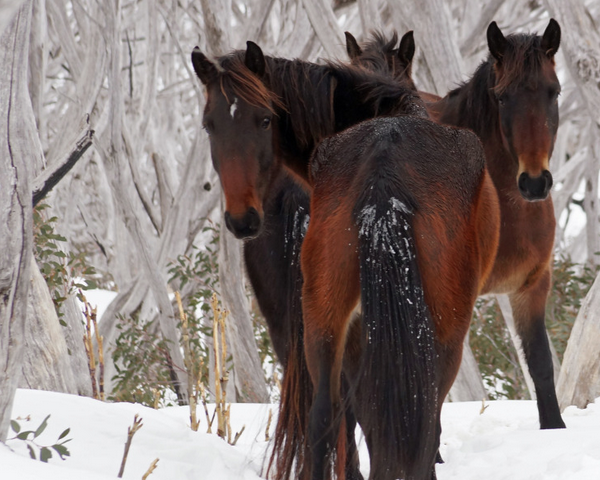Increased publicity surrounding the conditions and management of wild horses (or brumbies, as they’re known colloquially) has coincided with the review of both the Victorian Alps and Kosciuszko National Park five-year Wild Horse Management Plans.
The New South Wales Parks and Wildlife service currently has a public consultation process open through November, while the Victorian government utilised a roundtable group and public consultation to produce a draft management plan that will then be opened back up to the public.
The consultative approach taken by state governments has resulted in stakeholders from all backgrounds voicing strong opinions on the best way to control brumby populations in protected areas, and how much control is necessary.
According to some, not only is the health and viability of one of the country’s iconic ecosystems at stake, so too is the welfare of the horses themselves, which are have been found trapped and starving in isolated mountain passes over the winter, such as recently described in the aptly named Dead Horse Gap.
Most graphically, associate professor Don Driscoll and Dr. Sam Banks, researchers at the Australian National University and writing in The Conversation, witnessed starving horses fossicking within the abdominal cavity of their deceased counterpart, positing that the starving brumbies were ‘nibbling at what little remained of its digestive tract’.
As an environmental researcher, Driscoll has witnessed the devastating effects hoofed animals of all kinds are having on the high country, with native species like the particularly sensitive and endangered corroborree frog bearing the brunt of the invasion.
Driscoll told Wild: “The damage we’ve seen caused by the higher numbers of horses is massive.”
“The flats are an ecosystem completely dominated by horses. Native plants are eaten down, and invasive plants are spreading with horse manure everywhere; river banks have been completely caved in in many places and are now devoid of vegetation,” he said. “There are no natural enemies of these horses other than the weather and the occasional toxic plant, leaving their populations to grow at an alarming rate of over 15 per cent every year.”
Driscoll believes that, while national parks should ideally be reserved for native species alone, feral horse numbers should be managed much more effectively even if it isn’t realistic to remove them completely.
The only way to do so, he said, is by systematic aerial culling – a method that’s far from universally supported.
Head of the Snowy Mountain Horseriders Association and long time resident of the region Leisa Caldwell told Wild that she supported the management of wild horses in the high country, but that “it is spurious to suggest that the brumbies are having any permanent or serious environmental impacts on catchments when compared to landslides, bushfires and floods”.
“Horses have existed here for over 160 years, but it’s only the last decade or so that they’ve suddenly become an issue. It’s clear their numbers have risen in recent years since the 2003 fires that killed around half the population, but you could probably point to management issues in the national parks for that.”
The Parks Victoria website lists the 2003 fires as having subsequently triggered a sudden boom in the wild horse population, with ‘latest estimates suggest[ing] that in 2012 there were 8200 – 10,900 wild horses in the Victorian Alps’.
“Meanwhile, the horsemen that have traditionally managed the animals there suddenly no longer have access to what they consider ancestral territory,” Caldwell tells us. “There are whole communities – whole towns that used to be there, but now you wouldn’t even know they ever existed.”
Both Driscoll and Caldwell believe that there is a deep ideological divide that is at the root of the problem, and it isn’t simply a question of invasive species management or animal welfare.
Ultimately, most agree that the feral horse populations need to be controlled in the area, but opinions vary widely on how to achieve this in the most humane way and Caldwell argues that these decisions should be made and implemented by the people who have the greatest connection to the land.
“It’s fine for the bushwalkers to enjoy their wilderness experience alone and to themselves, but they should not resent our relationship with the mountains and our heritage that goes with it,” she said. “The brumbies are sacred as they, and the management of them, are the last link to our heritage that we treasure and we will never allow them to be culled inhumanely.”
As the consultation period for both Victorian and NSW horse management plans draws to a close, it appears that the respective parks authorities will be forced to make a decision that leaves at least one group grossly dissatisfied.


